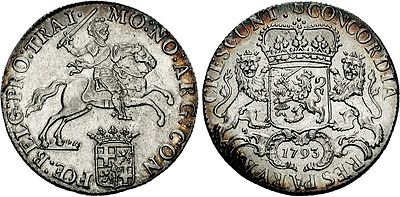Ducaton
The first ducaton-type coin was the scudo known as the 'ducatone da soldi cento' (of 100 soldo), issued by Charles V, Holy Roman Emperor, in Milan in 1551.Ducatones were produced in greater numbers in numerous Italian states through the 17th century, spreading to other parts of the Spanish Empire, including Burgundy and the Netherlands - in 1618 the ducaton was produced in Brabant and Tournai comprising 32.48 grams of 0.944 silver depicting Albert and Isabella.In 1659 the Dutch states started production of the 'silver rider' ducaton, featuring a mounted knight on horseback.This design weighing 32.779 grams of 0.941 silver also featured the crowned arms of the United Netherlands on the reverse, with a shield below the knight indicating the province of minting.In the period 1726-1751 ducatons were minted bearing the monogram of the Dutch East India Company.
History of coins in ItalyCharles V, Holy Roman EmperorBrabantTournaiAlbertIsabellaUtrechtUnited NetherlandsDutch East India Companytrade coinSpanish dollarstuiversDutch rijksdaalderThalerguilderCoinage of CalesCoinage of CapuaCoinage of SuessaCoinage of the Social WarGreek coinage of Italy and SicilyEtruscan coinsRoman currencyAgontanoAugustalisBaioccoBologninoCavalloCoinage of the Republic of SienaCoinage of the Republic of VeniceCraziaFlorinGenoese liraGenovinoGigliatoGiulioItalian scudoLombard coinageAdelchisBeneventoPierrealeQuattrinoSequinTorneselVenetian grossoVenetian liraCagliareseLombardo-Venetian florinLombardo-Venetian liraLuccan liraMilanese scudoNeapolitan liraNeapolitan piastraPapal liraParman liraPiedmontese scudoRoman scudoSardinian liraSardinian scudoSicilian piastraTuscan florinTuscan liraTwo Sicilies ducatItalian liraAM-LiraItalian euro coinscommemorativeEconomy of ItalyEconomic history of Italy